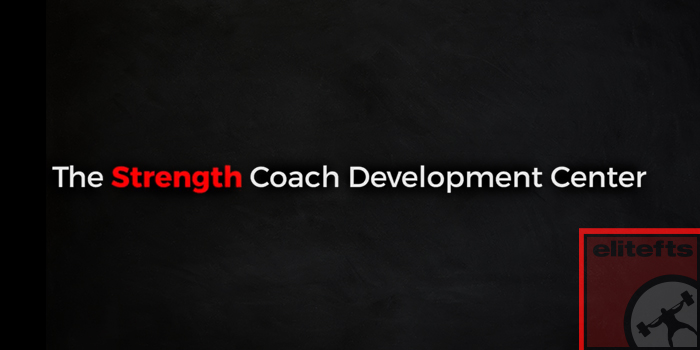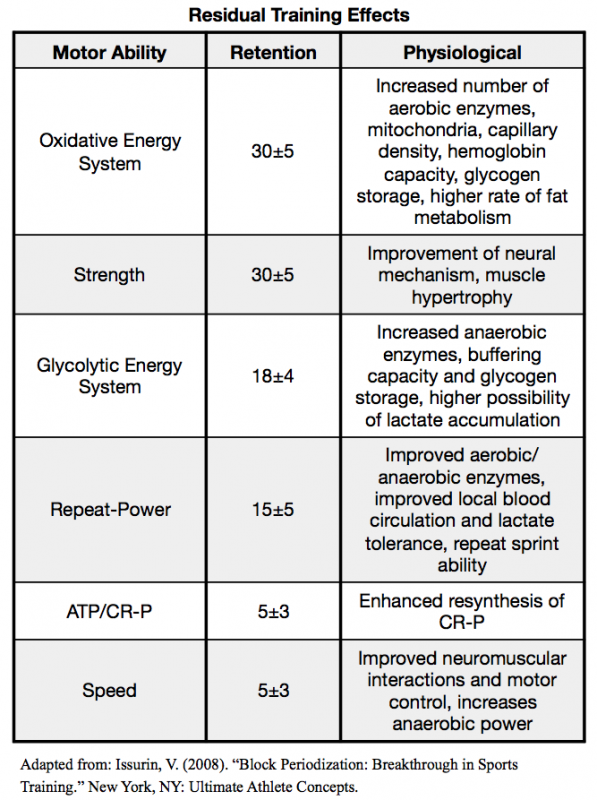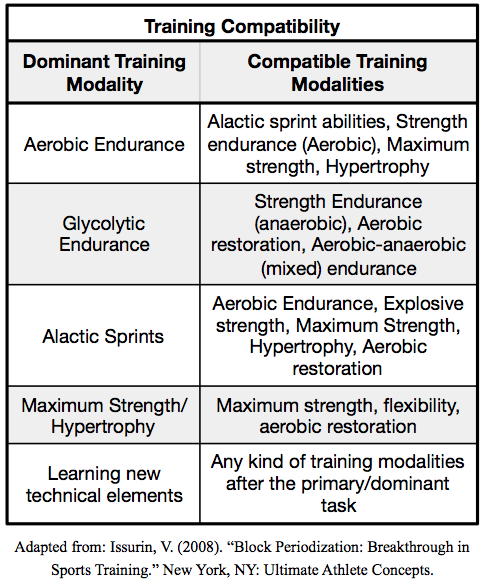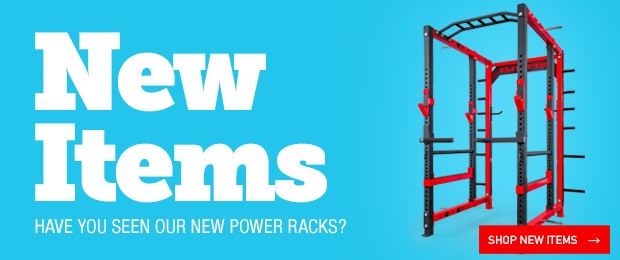
Disclaimer: This series is written for those that are new to the field. It is not an end all, be all on programming and periodization. It is meant to cover the basic topics and how to apply them. This is not meant to cover every aspect of said subjects, as for a new coach there is more than enough that they are attempting to learn. I have taken as many resources in strength training possible and condensed it into a "Reader's Digest" version. I am by no means the most knowledgeable person about periodization, programming, or research interpretation. The following is probably best considered as a potentially flawed but useful way to approach programming and periodization for the new coach.
Introduction
In this article, we are going to go over residual training effects, training compatibility, and how to construct a needs analysis for any sport. This is setting us up so we can start to put our macrocycles, mesocycles, and microcycles together. I hope you’ve been doing your assignments, as they are all building on each other. If you haven’t been, you need to go back to the previous articles and do them. These assignments are to help you build your toolbox with the tools you need to create effective programs for the length of your career. While these may seem tedious, once you’re done with them, you’re done. You can revisit them yearly but having these documents done will help you immensely.
Section 1: Residual Training Effects and Training Mode Compatibility
When building your annual plan, there are a few things you want to keep in mind. The first is residual training effects. Vladimir Issurin defined residual training effects in his book on block periodization as the retention of changes in the body state and motor abilities after the cessation of training beyond a certain time period. This refers to how long after you stop training a certain quality you can retain the abilities. This is an important concept to understand, as you have to know how fast you will lose the obtained ability when you stop training it. This will allow you to optimally program your yearly cycles and implement stress according to its retention length.
As you can see, strength and endurance retain their adaptations for the greatest length of time. The reason this is important is that you will want to adapt the qualities with longer residuals first, as then you can focus on those with shorter residuals later on in the training cycle while these two remain elevated. Something else to keep in mind is the role previous training plays. If a specific quality has been trained to a great extent previously, it will be regained by an athlete more rapidly than if it has not been previously trained. This is important, especially when it comes to our in-season training, as we will want to simultaneously peak these qualities.
The next thing we want to keep in mind is training mode compatibility. Some training modalities work better with others. This is important when developing your programs. Combining modalities that are compatible with each other allows you to emphasize the acute effect of the dominant training modality, but you also need to be cautious when using multiple modalities to ensure they are compatible.
The fact that alactic sprints are compatible with five other training modalities doesn’t mean you should focus on all five at once. Your program should contain no more than two to three training modalities at a time with 60% to 70% of the focus on the main modality. The reason for this is so that we can produce a sufficient stimulus to elicit the desired training effect.
Part 2: The Needs Analysis
One of the biggest things you need when designing a program is a needs analysis of the sport. If you don't know exactly what the sport you're programming for needs, how can you give your athletes the best chance to succeed? Your needs analysis of the sport should include but is not limited to a sport breakdown, physiological, movement, and injury analysis. If you’re in a high or collegiate setting, the first thing you’re going to want to do is interview the sport coach. Remember that you’re an assistant coach, so when developing your program you need to take into consideration what the sport coach wants to see. Some of the things you will want to discuss are the year's plan, competition priorities, and practice style. You'll also want to develop a tactical strategy to ensure both of you on the same page. We hear all the time how sport coaches and strength coaches butt heads over how the athletes should be trained. Remember to put your ego aside. This isn’t about you; it’s about the kids. There will be some give and take when it comes to the training. In the private setting I encourage you to reach out to the sport coaches in your area to start building relationships. If the high schools have a strength coach, meet with them. See how you can help their program.
The sport breakdown requires you to figure out what the bioenergetic requirements are for the sport. The movement analysis allows you to determine what the body and limb movement patterns are of the sport, along with what muscles are most involved. From there we like to do an injury analysis, which allows us to determine what the most common sites for joint and muscle injury are, as well as learning the factors that cause these injuries. Next, we need to do a physiological analysis of the sport, which allows us to understand what energy systems are most utilized during the sport. It will also help us to determine if the sport needs strength, power, hypertrophy, muscle endurance, or a mixture of all during their yearlong program. After doing our needs analysis of the sport we can determine if we need to test anaerobic power, agility, endurance, strength, flexibility, or repeated sprints, and what tests will be best suited to test those characteristics.
READ: Practical Application for Developing Rotational Power
Once we have done a needs analysis of the sport we need to do one of the individual athletes. We need to evaluate the training status of the athletes, their injury status, and conduct tests that will allow us to test the individual requirements of the sport. We need to determine what physical characteristics an athlete has and their strengths and weaknesses. In other words, what will support performance and what will limit performance? We do this by implementing a battery of tests pertinent to their sport, which we uncovered with our needs analysis. Don’t use tests just to use them. If they don’t have any correlation to the sport then don’t waste time. The tests need to be meaningful. Within this we should determine the objectives of our athletes' training, or what they need to achieve and when they need to achieve it. We need to keep in mind the athletes' competitive calendar and where they are in it.
Your program needs to be an athlete-centered approach. One program doesn’t fit them all. This is the problem with cookie-cutter programs — not all athletes have the same needs. You can have differences amongst a whole team. From injuries to age to position, all athletes are different. What this means is that you need to look at the individual athlete and program accordingly. Now, I realize this doesn't always seem possible in a team setting, but in all actuality it is. You just need to have the proper assessments and tests inline. You will see common injuries and training statuses exist throughout most teams. So to make your program individualized, all you need to do is change what the athlete needs to work on during the main focus of the workout. If they have a back injury, don’t free squat them. Maybe belt squat them or even front squat them. If they need extra shoulder prehab, build it into your workout for the athlete. Do your job by giving the athletes what they need.
Football Needs Analysis Example
Breakdown of the Sport:
- Average play duration: 4 to 6 seconds
- Average time between plays: 15 to 40 seconds, depending on the style of offense
- Average series in a game: 10 to 18
- Average plays in a series: 3 to 15
- Distance typically covered: 5 to 40 yards
As you can see, football is an alactic-aerobic sport. They have high-intensity efforts with short, incomplete recovery periods lasting 20 to 40 seconds. Athletes may venture in the lactic system with longer play or the time between is too short for the athletes to recover. This is why a larger aerobic base is so important. Mental toughness is important toward the end of the fourth quarter, but be a good performance coach and give those athletes a big-ass gas tank so they can perform as close to their maximal output as possible.
Physiological Analysis:
- Explosive bouts with short rest intervals (alactic/anaerobic power with a high aerobic capacity)
- Strength
- Power and explosiveness
- Hypertrophy
Movement and Injury Analysis:
- Constant change in movements
- Receives impact from external objects
- Requires optimum speed and accuracy
- Requires balance, locomotion, and maximum effort in speed, power, and force
- Involves all plains of monition on all axes of motion
- Major joints involved include shoulder, hips, knees, neck, and ankles
- Major injuries include concussions, knee injuries (ACL, PCL, and menisci), ankle sprains, and shoulder injuries.
Tests:
Pick the tests you feel are best for your program that you and the sport coach decide on.
- Movement screen of choice
- Vertical jump
- Broad jump
- L-Drill
- Pro shuttle
- Max strength tests
- Conditioning tests that best mimic the sport
Like most team sports, there are a variety of positions involved. This means that each position has slightly different energy requirements, and this will typically be addressed with their sprint distances and the amount of time doing various exercises, along with the rest intervals. When doing your individual athlete assessments, position requirements need to be taken into consideration. There’s no reason to have your linemen consistently running 50-yard sprints if they generally only cover one to 10 yards each play. This is not to say that they shouldn’t run 30 yards so they are exposed to it, but that’s more along the lines of what you need for your skilled positions who typically cover the most yardage on a given play. You will also want to take into consideration how each position is played, as this will help you choose what types of exercises you should utilize with each position.
Assignment
Create a needs analysis for every sport that you oversee.













